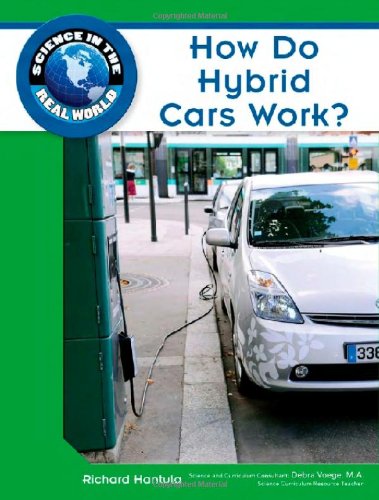-
How Do Hybrid Cars Work?
Richard Hantula
Hardcover (Chelsea Clubhouse, Sept. 1, 2009)Discusses how these machines work, the science behind the energy they make, and what the use of hybrid cars means for the planet. P
P
-
The Scientific Method in the Real World
L E Carmichael
Paperback (Core Library, Jan. 1, 2013)Examines the history of the scientific method and describes each of its components, which include making observations, asking questions, creating hypotheses, running experiments, and looking for patterns in the results. V
V
-
Magnets in the Real World
Chris Eboch
Library Binding (Core Library, Jan. 1, 2013)Discusses how magnets work, shares examples of how they are used around the house, in transportation, and in medicine, and provides a brief history of the study of magnetism. S
S
-
States of Matter in the Real World
Roberta Baxter
Library Binding (Core Library, Jan. 1, 2013)Science is everywhere! Science in the Real World uses real-world examples to bring scientific concepts to life in an approachable way. Clearly-written text draws in readers with concrete examples involving familiar, everyday things. They’ll learn about electricity, energy, force, motion, light, magnets, the scientific method, sound, and states of matter. Compelling, full-color photos, a glossary, an index, sidebars, primary source documents, and other creative content enhance each book. The books include prompts and activities that directly engage students in developing the reading, writing, and critical thinking skills promoted by the Common Core standards. These well-researched titles have credentialed content consultants. And, they are aligned to Common Core standards and correlated to state standards. Core Library is an imprint of ABDO Publishing Company. W
W
-
How Does a Spacecraft Reach the Moon?
Barbara J Davis, Debra Voege
Hardcover (Chelsea Clubhouse, Sept. 1, 2009)The Moon is very far from Earth. Yet, scientists have been able to get satellites, shuttles, and other spacecraft into space and a few manned spacecraft to land on the Moon. This title reveals the science behind propulsion and the energy it takes to get large craft into space. It also includes photographs and illustrations. P
P
-
Electricity and Magnetism
Dana Meachen Rau
Library Binding (Cherry Lake Pub, Jan. 1, 2009)Discusses electricity and magnetism, and explains the ways in which they make many household objects work. S
S
-
Engineering in Your Everyday Life
Danell Dykstra
Paperback (Enslow Publishing, July 15, 2019)How many day-to-day important devices are engineering design products? How does a smartphone send wireless communication? How do batteries release energy? These and other questions are explained using straightforward language that weaves in science terminology and is accompanied by intriguing photographs. Easy experiments demystify engineering concepts with step-by-step instructions to make bioplastics, bridges, motors, and robot arms. Sidebars explore high-interest current developments such as drones, 3D printing, and self-driving cars. Based on the Next Generation Science Standards, this book helps students understand the engineering design process and boosts their physical science knowledge of matter, forces, energy, and waves. Y
Y
-
Energy in the Real World
Christine Zuchora-Walske
Library Binding (Core Library, Jan. 1, 2013)Introduces energy, provides an overview its history, and discusses kinetic and potential energies. S
S
-
Why Do the Lights Turn On?
Barbara J Davis, Debra Voege
Hardcover (Chelsea Clubhouse, Sept. 1, 2009)When you walk into a room and flip a light switch, a lightbulb turns on, illuminating the area. But how does one small switch do such a large job? This title enlightens readers about the science behind electricity and circuits through full-color illustrations and photographs. O
O
-
Chemistry in Your Everyday Life
Thomas R. Rybolt
Paperback (Enslow Publishing, July 15, 2019)How do soaps and detergents clean? Why do metals conduct electricity? How does burning fossil fuel contribute to global warming? The answers to these questions are found by examining the properties and behaviors of atoms and molecules. Insightful explanations and hands-on science activities simplify complicated chemistry principles into pieces of information that are more easily grasped. Sidebars include discussions on animals that can live thirty years without water, the Maillard reaction responsible for the taste and texture of french fries, the increase of carbon dioxide in the atmosphere, and how tires provide a cushion of air to smooth our rides. This book allows students to appreciate that when it comes to understanding the world around us, tiny molecules can provide big explanations.
-
How Do Plants Get Food?
Barbara J Davis, Debra Voege
Hardcover (Chelsea Clubhouse, Sept. 1, 2009)When people get hungry, they eat a meal. All animals and plants need water and sustenance to survive and grow. Animals get their energy from eating food, but plants have a different method. This title exposes how plants get food and make energy through photosynthesis. Q
Q
-
Electricity in the Real World
Sarah E Ward
Library Binding (Core Library, Jan. 1, 2013)Introduces electricity, provides an overview of its history, and discusses different ways it can be made. U
U